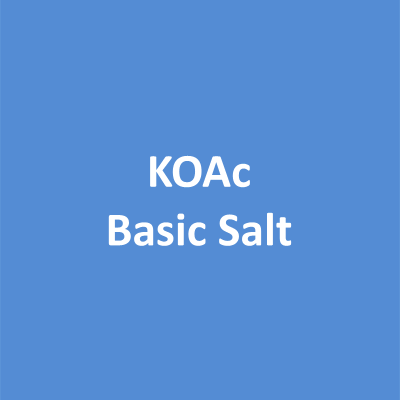13. Acid-Base Properties of Salts
When dissolving NaCl in water, it breaks up into ions:
NaCl  Na+ + Cl-
Na+ + Cl-
The positive Na+-ion is an acid: conjugate acid of the base NaOH. This is a strong base: Kb >> 1. As Ka x Kb = 10-14, this means that Ka for the Na+-ion is much smaller than 10-14 and thus the Na+-ion is a much weaker acid than water. It will have no influence on the pH.
The negative Cl--ion is a base: conjugate base of the acid HCl. This is a strong acid: Ka >> 1. As Ka x Kb = 10-14, this means that Kb for the Cl--ion is much smaller than 10-14 and thus the Cl--ion is a much weaker base than water. It will have no influence on the pH.
When dissolving NaCl in water, three particles are present: Na+ (acid) , Cl- (base) and H2O (amfolyt). The strongest acid is H2O, the strongest base is also H2O. The solution will be neutral.
A salt that consists of a cation of a strong base and an anion of a strong acid has no effect on pH when dissolved in water.
NaCl , KCl , CaCl2 , BaCl2 , NaNO3 , KNO3 , Ca(NO3)2 , Ba(NO3)2 , ...

When dissolving NH4NO3 in water, it breaks up into ions:
NH4NO3  NH4+ + NO3-
NH4+ + NO3-
The positive NH4+-ion is an acid: conjugate acid of the base NH3. This is a weak base: Kb = 1.8 x 10-5. As Ka x Kb = 10-14, this means that
Ka for the NH4+-ion is equal to 5.6 x 10-10 and thus the NH4+-ion is a weak acid, but stronger than water. It will have an influence on the pH.
The negative NO3--ion is a base: conjugate base of the acid HNO3. This is a strong acid: Ka >> 1. As Ka x Kb = 10-14, this means that Kb for the NO3--ion is much smaller than 10-14 and thus the NO3--ion is a much weaker base than water. It will have no influence on the pH.
When dissolving NH4NO3 in water, three particles are present: NH4+ (acid) , NO3- (base) and H2O (amfolyt). The strongest acid is NH4+, the strongest base is H2O. The solution will be acidic.
A salt that consists of a cation of a weak base and an anion of a strong acid produces an acidic solution when dissolved in water.
NH4Cl , NH4Br , NH4I , NH4NO3 , ...
The same goes for salts from an amine and a strong acid. And also for salts that consists of an anion of a strong acid and a cation that either:
- has a high charge density (Al3+, Be2+ )
- acts as a
lewis acid (ex. Fe3+, Cu2+, Zn2+ , ...)
Examples: Al(NO3)3, FeCl3, ZnCl2,
Cu(NO3)2, ...


When dissolving KOAc in water, it breaks up into ions:
KOAc  K+ + OAc-
K+ + OAc-
The positive K+-ion is an acid: conjugate acid of the base KOH. This is a strong base: Kb >> 1. As Ka x Kb = 10-14, this means that
Ka for the K+-ion is much smaller than 10-14 and thus the K+-ion is a much weaker acid than water. It will have no influence on the pH.
The negative OAc--ion is a base: conjugate base of the acid HOAc. This is a weak acid: Ka = 1.8 x 10-5. As Ka x Kb = 10-14, this means that
Kb for the OAc--ion is equal to 5.6 x 10-10 and thus the OAc--ion is a weak base, but stronger than water. It will have an influence on the pH.
When dissolving KOAc in water, three particles are present: K+ (acid) , OAc- (base) and H2O (amfolyt). The strongest acid is H2O, the strongest base is OAc-. The solution will be basic.
A salt that consists of a cation of a strong base and an anion of a weak acid produces an basic solution when dissolved in water.
NaOAc , KOAc , NaF , KF , NaCN , KCN , ...


Summary
Acid-Base Properties of Salts
|
| A salt that consists of a cation of a strong base and an anion of a strong acid has no effect on pH when dissolved in water.
A salt that consists of a cation of a weak base and an anion of a strong acid produces an acidic solution when dissolved in water.
A salt that consists of a cation of a strong base and an anion of a weak acid produces an basic solution when dissolved in water. |